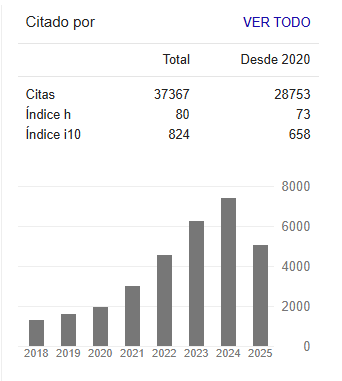Liderazgo emprendedor y compromiso con el proceso creativo para la innovación
Resumen
El propósito general de esta investigación fue analizar el impacto de las características del liderazgo emprendedor sobre el compromiso con el proceso creativo para la innovación en los empleados de las pequeñas y medianas empresas (Pymes). Con un diseño de sección transversal los datos se obtuvieron de 300 empleados de pequeñas y medianas empresas (Pymes) de los sectores de manufactura y agropecuario, de las ciudades de Lima, Arequipa y la Provincia Constitucional del Callao de Perú. Los resultados revelaron que el liderazgo emprendedor produce un impacto positivo y significativo sobre el compromiso con el proceso creativo para la innovación en los empleados de las empresas. Las conclusiones denotaron que el conocimiento de las características de los líderes emprendedores en los gerentes de las organizaciones impulsa el compromiso con el proceso creativo para la innovación en los empleados en su desempeño.
Citas
Amabile, T. M. (1983). The social psychology of creativity: A componential conceptualization. Journal of Personality and Social Psychology, 45(2), 357–376. https://doi.org/10.1037/0022-3514.45.2.357
Amabile, T.M. (1988). A Model of creativity and innovation in organizations. In B.M. Staw, & L.L. Cummings, (Eds.). Research in organizational behavior (pp. 123–167). JAI Press
Amabile, T.M., Conti, R., Coon, H., y Herron, M. (1996). Assessing the Work Environment for Creativity. Academy of Management Journal, 39, 1154-1184.
http://dx.doi.org/10.2307/256995
Anderson, J.C. & Gerbing, D. W. (1988). Structural equation modeling in practice: A review and recommended twostep approach. Psychological Bulletin, 103(3), 411-423. https://doi.org/10.1037/0033-2909.103.3.411
Bagozzi, R. & Yi, Y. (1988). On the evaluation of structural equation models. Journal of the Academy of Marketing Science, 16, 74-94. https://doi.org/10.1007/bf02723327
Byrne, B. (2016). Structural Equation Modeling with AMOS. Basic Concepts, Applications and Programming, 3rd edition. Routledge.
Cai, W., Lysova, E.I., Khapova, S.N. & Bossink, B.A. (2019). Does entrepreneurial leadership foster creativity among employees and teams? The mediating role of creative efficacy beliefs. Journal of Business and Psychology, 34(2), 203-217. https://doi.org/10.1007/s10869-018-9536-y
Chen, L., Wadei, K. A., Bai, S. & Liu, J. (2020). Participative leadership and employee creativity: a sequential mediation model of psychological safety and creative process engagement. Leadership & Organization Development Journal, 41(6), 741–759. https://doi.org/10.1108/lodj-07-2019-0319
Cheng, C. & Yang, M. (2019). Creative process engagement and new product performance: The role of new product development speed and leadership encouragement of creativity. Journal of Business Research, 99, 215–225. https://doi.org/10.1016/j.jbusres.2019.02.067
Creswell, J. & Creswell, J. (2018). Research design: qualitative, quantitative, and mixed methods approaches, (5th ed.) Sage.
Darling, J, Keefe, M. & Ross, J. (2007). Entrepreneurial leadership strategies and values: Keys to operational excellence. Journal of Small Business and Entrepreneurship, 20(1), 41-54. https://doi.org/10.1080/08276331.2007.10593385
DeVellis, R. (2017). Scale development: theory and applications. Fourth edition. Sage.
Falk, R. F., & Miller, N.B. (1992). A primer for soft modeling: Ohio: University of Akron Press
Fontana, A. & Musa, S. (2017). The impact of entrepreneurial leadership on innovation management and its measurement validation. International Journal of Innovation Science, 9(1), 2-19. https://doi.org/10.1108/ijis-05-2016-0004
Fornell, C., & Larcker, D. F. (1981). Structural Equation Models with Unobservable Variables and Measurement Error: Algebra and Statistics. Journal of Marketing Research, 18(3), 382-388. https://doi.org/10.2307/3150980
Frese, M. & Gielnik, M. M. (2014). The psychology of entrepreneurship. Annual Review of Organizational Psychology and Organizational Behavior, 1(1), 413–438. https://doi.org/10.1146/annurev-orgpsych-031413-091326
Green, S., Lissitz, R., Mulaik, S. (1977). Limitations of coefficient alpha as an index of test unidimensionality. Educational and Psychological Measurement, 37(4), 827-838. https://doi.org/10.1177/001316447703700403
Gupta, V, MacMillan, I.C. & Surie, G. (2004). Entrepreneurial leadership: developing and measuring a cross-cultural construct. Journal of Business Venturing, 19(2), 241-260. https://doi.org/10.1016/s0883-9026(03)00040-5
Hair, J., Babin, B., Anderson, R., & Black, W. (2019). Multivariate Data Analysis (8th ed.). Cengage.
Illies, J. J., & Reiter-Palmon, R. (2004). The effects of type and level of personal involvement on information search and problem solving. Journal of Applied Social Psychology, 34, 1709–1729. https://doi.org/10.1016/S1475-9144(07)00009-4
Iqbal, A., Nazir, T. & Ahmad, M.S. (2020). Entrepreneurial leadership and employee innovative behavior: an examination through multiple theoretical lenses. European Journal of Innovation Management, 1-18. https://doi.org/10.1108/ejim-06-2020-0212
Khalili, A. (2016). Linking transformational leadership, creativity, innovation, and innovation supportive climate. Management Decision, 54(9), 2277-2293. https://doi.org/10.1108/MD-03-2016-0196
Khurosani, A. (2018). Transformational leadership, employee creativity and organizational innovation, the intervening role of organizational learning culture. Advanced Science Letters, 29(4), 2557-2560. https://doi.org/10.1166/asl.2018.11004
Kline, R. (2016). Principles and practice of structural equation modeling. (4th ed.). Guilford Press.
Leitch, C.M. & Volery, T. (2017). Entrepreneurial leadership: insights and directions. International Small Business Journal, 35(2), 147-156. https://doi.org/10.1177/0266242616681397
Li, C., Makhdoom, H. & Asim, S. (2020). Impact of entrepreneurial leadership on innovative work behavior: Examining mediation and moderation mechanisms. Psychology research and behavior management, 13, 105–118. https://doi.org/10.2147/PRBM.S236876
Mehmood, M., Jian, Z., Akram, U. & Tariq, A. (2020). Entrepreneurial leadership: the key to develop creativity in organizations. Leadership & Organization Development Journal, 1-20. https://doi.org/10.1108/LODJ-01-2020-0008
Mahmood, M., Uddin, M. A., & Fan, L. (2019). The influence of transformational leadership on employees’ creative process engagement. Management Decision, 57(3), 741-764. https://doi.org/10.1108/md-07-2017-0707
Mainemelis, C., Kark, R. & Epitropaki, O. (2015). Creative Leadership: A Multi-Context Conceptualization. Academy of Management Annals, 9(1), 393–482. https://doi.org/10.5465/19416520.2015.1024502
Musa, S. & Fontana, A. (2014). Measuring entrepreneurial leadership in innovation management [Conceptual framework]. The ISPIM Asia-Pacific Innovation Forum 2014. ISPIM.
Newman, A., Neesham, C., Manville, G. & Tse, H.H.M. (2017). Examining the influence of servant and entrepreneurial leadership on the work outcomes of employees in social enterprises. International Journal of Human Resource Management, 29(20), 1-22. https://doi.org/10.1080/09585192.2017.1359792
Nicholson, N. (1998). Personality and entrepreneurial leadership: A study of the heads of the UK’s most successful independent companies. European Management Journal, 16(5), 529–539. https://doi.org/10.1016/s0263-2373(98)00030-9
Raykov, T. (2011). Introduction to psychometric theory. Routledge.
Reiter-Palmon, R. & Illies, J.J. (2004). Leadership and creativity: Understanding leadership from a creative problem-solving perspective. Leadership Quarterly, 15(1), 55–77. https://doi.org/10.1016/j.leaqua.2003.12.005
Renko, M., El Tarabishy, A., Carsrud, A.L. & Brännback, M. (2015). Understanding and measuring entrepreneurial leadership style. Journal of Small Business Management, 53(1), 54-74. https://doi.org/10.1111/jsbm.12086
Scott, S.G. & Bruce, R.A. (1994). Determinants of innovative behavior: A path model of individual innovation in the workplace. Academy of Management Journal, 37(3), 580-607. http://www.jstor.org/stable/256701
Shalley, C.E. & Gilson, L.L. (2004). What leaders need to know: A review of social and contextual factors that can foster or hinder creativity. Leadership Quarterly, 15(1), 33–53. https://doi.org/10.1016/j.leaqua.2003.12.004
Shalley, C.E., Gilson, L.L. & Blum, T.C. (2000). Matching creativity requirements and the work environment: Effects on satisfaction and intent to turnover. Academy of Management Journal, 43, 215–224. https://doi.org/10.2307/1556378
Taber, K. (2018). The use of Cronbach’s Alpha when developing and reporting research instruments in science education. Research in Science Education, 48(1), 1-24. https://doi.org/10.1007/s11165-016-9602-2
Tse, H. H., To, M. L., & Chiu, W. C. (2018). When and why does transformational leadership influence employee creativity? The roles of personal control and creative personality. Human Resource Management, 57(1), 145-157. https://doi.org/10.1002/hrm.21855
Ursachi, G., Horodnic, I. A. & Zait, A. (2015). How reliable are measurement scales? External factors with indirect influence on reliability estimators. Procedia Economics and Finance, 20, 679 – 686. https://doi.org/10.1016/S2212-5671(15)00123-9
Vecchio, R. P. (2003). Entrepreneurship and leadership: common trends and common threads. Human Resource Management Review, 13(2), 303–327. https://doi.org/10.1016/s1053-4822(03)00019-6
Yi, L., Uddin, M. A., Das, A. K., Mahmood, M. & Sohel, S.M. (2019). Do Transformational leaders engage employees in sustainable innovative work behaviour? Perspective from a developing country. Sustainability, 11(9), 2485, pp. 1-18. https://doi.org/10.3390/su11092485
Zhang, X., & Bartol, K. (2010a). Linking empowering leadership and employee creativity: The influence of psychological empowerment, intrinsic motivation, and creative process engagement. Academy of Management Journal, 53(1), pp. 107–128. https://doi.org/10.5465/amj.2010.48037118
Zhang, X. & Bartol, K. M. (2010b). The influence of creative process engagement on employee creative performance and overall job performance: A curvilinear assessment. Journal of Applied Psychology, 95(5), 862–873. https://doi.org/10.1037/a0020173
Zhao, H., Hills, G. E., & Seibert, S.E. (2005). The mediating role of self-efficacy in the development of entrepreneurial intentions. Journal of Applied Psychology, 90(6), 1265-1272. https://doi.org/10.1037/0021-9010.90.6.1265
Zhou, J., & Shalley, C.E. (2003). Research on employee creativity: A critical review and directions for future research. Research in Personnel and Human Resources Management, 22, 165-217. https://doi.org/10.1016/s0742-7301(03)22004-1

Esta obra está bajo licencia internacional Creative Commons Reconocimiento-NoComercial-CompartirIgual 4.0.








.png)






























